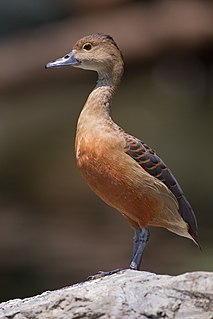
The lesser whistling duck, also known as Indian whistling duck or lesser whistling teal, is a species of whistling duck that breeds in the Indian subcontinent and Southeast Asia. They are nocturnal feeders that during the day may be found in flocks around lakes and wet paddy fields. They can perch on trees and sometimes build their nest in the hollow of a tree. This brown and long-necked duck has broad wings that are visible in flight and produces a loud two-note wheezy call. It has a chestnut rump, differentiating it from its larger relative, the fulvous whistling duck, which has a creamy white rump.

Manis is a genus of pangolins.
Cyathea javanica is a species of tree fern native to western Java and Sumatra, in Indonesia.
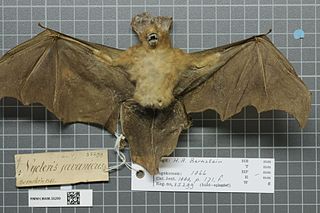
The Javan slit-faced bat is a species of slit-faced bats found on the Kangean Islands of Indonesia and Nusa Penida, Java. This species is also located in West Timor. This species' population is decreasing.
Meloidogyne javanica is a species of plant-pathogenic nematodes. It is one of the tropical root-knot nematodes and a major agricultural pest in many countries. It has many hosts. Meloidogyne javanica reproduces by obligatory mitotic parthenogenesis (apomixis).
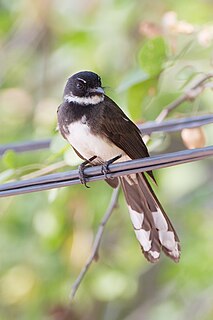
The Malaysian pied fantail is a species of bird in the fantail family and one of 47 species in the genus Rhipidura. It is locally referred to as murai gila, literally "crazy thrush" in the Malay language. It is found in Brunei, Cambodia, Indonesia, Laos, Malaysia, Myanmar, Philippines, Singapore, Thailand, and Vietnam. Its natural habitat is subtropical or tropical moist lowland forests.
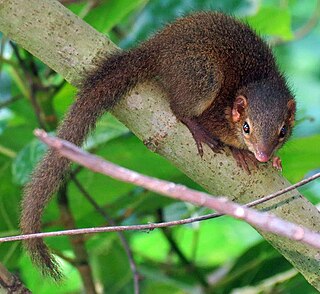
Horsfield's treeshrew, also called Javan treeshrew, is a treeshrew species within the Tupaiidae. It is endemic to the Indonesian islands of Sumatra, Bali, Java and Nias where it inhabits foremost primary forest.

The Sunda porcupine is a species of rodent in the family Hystricidae. It is endemic to Indonesia.

Aerva javanica, the kapok bush or desert cotton, is a species of plant in the family Amaranthaceae. It has a native distribution incorporating much of Africa, and the south-west and south of Asia, and it has become adventitious in northern Australia.

Japonica rice, sometimes called sinica rice, is one of the two major domestic varieties of Asian rice. Japonica rice is extensively cultivated and consumed in China, Japan, Korea, and Taiwan, whereas in most other regions Indica rice is the dominant type of rice.
Thyas javanica is a species of moth of the family Noctuidae. It is found on Sumatra, Java, Bali, the Peninsular Malaysia and Borneo.
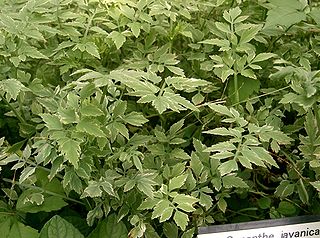
Oenanthe javanica, commonly Java waterdropwort, Chinese celery, Indian pennywort, Japanese parsley, water celery and water dropwort, is a plant of the water dropwort genus originating from East Asia.. It has a widespread native distribution in temperate Asia and tropical Asia, and is also native to Queensland, Australia.

Sambucus javanica, the Chinese elder, is a species of elderberry in the family Adoxaceae native to subtropical and tropical Asia. It is found naturally in Bhutan, Burma, Cambodia, China, India, Indonesia, Japan, Laos, Malaysia, the Philippines, southern Thailand, and Vietnam. It is a perennial herb or a small shrub 1–2 m tall.

Cassia javanica, also known as Java cassia, pink shower, apple blossom tree and rainbow shower tree, is a species of tree in the Fabaceae family. Its origin is in Southeast Asia, but it has been extensively grown in tropical areas worldwide as a garden tree owing to its beautiful crimson and pink flower bunches.
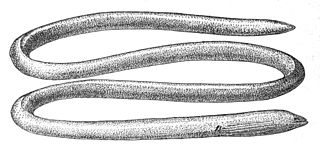
The Java spaghetti eel, also known as the Java thrush-eel, Java worm eel, and the black-tailed thrush eel is an eel in the family Moringuidae. It was described by Johann Jakob Kaup in 1856, originally under the genus Aphthalmichthys. It is a tropical, marine eel which is known from the Indo-Pacific, including East Africa, the Tuamoto Islands, the Ryukyu Islands, and Micronesia. It is a burrowing species which inhabits reefs at a depth range of 2–15 m. Males can reach a maximum total length of 120 cm.
Filopaludina javanica or Idiopoma javanica is a species of large freshwater snail with a gill and an operculum, an aquatic gastropod mollusk in the family Viviparidae.

Sybra is a genus of beetles in the family Cerambycidae, containing the following species:

Brucea javanica is a shrub in the family Simaroubaceae. The specific epithet javanica is from the Latin, meaning "of Java". Other common names in English include Java brucea and kosam.

Sybra ordinata is a species of beetle in the family Cerambycidae. It was described by Bates in 1873.
Castanopsis javanica, the Javan chestnut-oak, is a tree in the beech family Fagaceae. The specific epithet javanica is from the Latin, meaning "of Java".
















